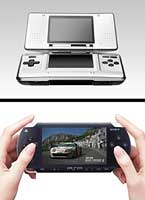|
|
|||||||
|
|
|||||||
|
|||||||
| | Web Japan >>| Trends in Japan >> | Lifestyle >> | Gaming on the Go | |
|
GAMING ON THE GO Adults the Target of Handheld Video-Game Systems (February 22, 2005) The competition for customers in the gaming industry stepped up a gear in late 2004, as two major makers of video-game systems engaged in a battle over the next generation of portable video-game systems. December 2 saw the debut of the Nintendo DS, which retails for ¥15,000 ($143 at ¥105 to the dollar), while the current leader in the game sector, Sony Computer Entertainment, released its first handheld platform on December 12, the PlayStation Portable (PSP), which costs ¥20,790 ($198). With sales of video-game consoles in Japan currently in the doldrums, the aim of these two companies is to develop a new fan base and win over adult consumers. Sony vs. Nintendo The PSP features a simple, lustrous design aimed at making it easier for adults to play video games outside in public without embarrassment. Equipped with a high-resolution liquid-crystal display and high-performance chips, the PSP offers a gaming experience in-line with what consumers have come to expect from Sony's PlayStation 2, which owns the lion's share of the market for home game consoles. The PSP can play video and music as well, and the manufacturer emphasizes that adults can use it to watch movies or enjoy music while passing time on the train or plane. The day the Nintendo DS went on sale, hordes of people lined up outside major electronic retailers in Tokyo's Shinjuku and Yurakucho districts. Some 570,000 units were sold in the first four days, with the figure rising to over 1 million when earlier sales in the United States are included. Nintendo then raised its sales target of 2 million units in Japan and the United States in 2004 to 2.8 million. While the PSP went on sale first, only a limited number of units - just 200,000 - were shipped immediately. The shortage served to drive demand for the product even higher. Will Handheld Games Revive the Market? Nintendo is trying to maintain its crown in the area of handheld game consoles, while Sony Computer Entertainment is looking to wrest control of the market, and the differences in their approaches can be seen in this light. Both, however, are aiming to attract a new fan base of adult gamers. Each of these firms hopes to fill the spare time that adults have while on the commuter train or during lunch breaks. This battle for the attention of adult consumers appears set to heat up even further. Copyright (c) 2005 Web Japan. Edited by Japan Echo Inc. based on domestic Japanese news sources. Articles presented here are offered for reference purposes and do not necessarily represent the policy or views of the Japanese Government. |
HOT TOYS IN JAPAN (February 27, 2003) CONSOLIDATION IS THE NAME OF THE GAME (February 25, 2003) |
|
|



